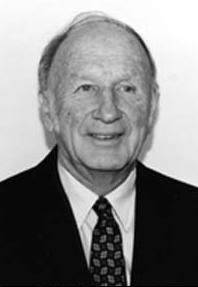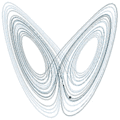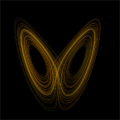Edward Lorenz (nonfiction): Difference between revisions
No edit summary |
No edit summary |
||
| (One intermediate revision by the same user not shown) | |||
| Line 130: | Line 130: | ||
== Fiction cross-reference == | == Fiction cross-reference == | ||
* [[Did you step on a butterfly in Texas during a tornado while watching Jurassic Park in Brazil under the influence of JJ-180?]] | |||
* [[Gnomon algorithm]] | |||
* [[Gnomon Chronicles]] | |||
== Nonfiction cross-reference == | == Nonfiction cross-reference == | ||
* Chaos theory | * [[Chaos theory (nonfiction)]] | ||
* Attractor | * [[Attractor (nonfiction)]] | ||
* [[Dynamical system (nonfiction)]] | * [[Dynamical system (nonfiction)]] | ||
* Experimental mathematics | * [[Experimental mathematics (nonfiction)]] | ||
* [[Initial condition (nonfiction)]] - a value of an evolving variable at some point in time designated as the initial time (typically denoted t = 0). For a system of order k (the number of time lags in discrete time, or the order of the largest derivative in continuous time) and dimension n (that is, with n different evolving variables, which together can be denoted by an n-dimensional coordinate vector), generally nk initial conditions are needed in order to trace the system's variables forward through time. | * [[Initial condition (nonfiction)]] - a value of an evolving variable at some point in time designated as the initial time (typically denoted t = 0). For a system of order k (the number of time lags in discrete time, or the order of the largest derivative in continuous time) and dimension n (that is, with n different evolving variables, which together can be denoted by an n-dimensional coordinate vector), generally nk initial conditions are needed in order to trace the system's variables forward through time. | ||
* Lorenz attractor | * Lorenz attractor | ||
| Line 145: | Line 149: | ||
* Jule Gregory Charney | * Jule Gregory Charney | ||
External links | == External links == | ||
* [https://en.wikipedia.org/wiki/Edward_Norton_Lorenz Edward Norton Lorenz] @ Wikipedia | * [https://en.wikipedia.org/wiki/Edward_Norton_Lorenz Edward Norton Lorenz] @ Wikipedia | ||
Latest revision as of 12:29, 2 November 2020
Edward Norton Lorenz (May 23, 1917 – April 16, 2008) was an American mathematician and meteorologist who established the theoretical basis of weather and climate predictability, as well as the basis for computer-aided atmospheric physics and meteorology. He is best known as the founder of modern chaos theory, a branch of mathematics focusing on the behavior of dynamical systems that are highly sensitive to initial conditions.
His discovery of deterministic chaos “profoundly influenced a wide range of basic sciences and brought about one of the most dramatic changes in mankind’s view of nature since Sir Isaac Newton,” according to the committee that awarded him the 1991 Kyoto Prize for basic sciences in the field of earth and planetary sciences.
Biographical information
Lorenz was born in 1917 in West Hartford, Connecticut. He acquired an early love of science from both sides of his family. His father, Edward Henry Lorenz, majored in mechanical engineering at the Massachusetts Institute of Technology, and his maternal grandfather, Lewis M. Norton, developed the first course in chemical engineering at MIT in 1888. Meanwhile, his mother, Grace Norton, instilled in Lorenz a deep interest in games, particularly chess.
Later in life, Lorenz lived in Cambridge, Massachusetts with his wife, Jane Loban, and their three children, Nancy, Cheryl, and Edward. He was an avid outdoorsman, who enjoyed hiking, climbing, and cross-country skiing. He kept up with these pursuits until very late in his life. On April 16, 2008, Lorenz died at his home in Cambridge, MA, from cancer at the age of 90.
Education
Lorenz received a bachelor's degree in mathematics from Dartmouth College in 1938 and a master's degree in mathematics from Harvard in 1940. He worked as a weather forecaster for the United States Army Air Corps during World War II, leading him to pursue graduate studies in meteorology at the Massachusetts Institute of Technology. He earned both a master's and doctoral degree in meteorology from MIT in 1943 and 1948.
His doctoral dissertation, titled "A Method of Applying the Hydrodynamic and Thermodynamic Equations to Atmospheric Models" and performed under advisor James Murdoch Austin, described an application of fluid dynamical equations to the practical problem of predicting the motion of storms.
Scientific career
Lorenz spent the entirety of his scientific career at the Massachusetts Institute of Technology. In 1948, he joined the MIT Department of Meteorology as a research scientist. In 1955, he became an assistant professor in the department and was promoted to professor in 1962. From 1977 to 1981, Lorenz served as head of the Department of Meteorology at MIT. In 1983, the MIT Department of Meteorology and Physical Oceanography merged with the Department of Geology to become the current MIT Department of Earth, Atmospheric and Planetary Sciences, where Lorenz remained a professor before becoming an emeritus professor in 1987.
Atmospheric circulation
In the late 1940s and early 1950s, Lorenz worked with Victor Starr on the General Circulation Project at MIT to understand the role the weather system played in determining the energetics of the general circulation of the atmosphere. From this work, in 1967, Lorenz published a landmark paper, titled "The Nature and Theory of the General Circulation of the Atmosphere," on atmospheric circulation from an energetic perspective, which advanced the concept of available potential energy.
Numerical weather prediction
In the 1950s, Lorenz became interested in and started work on numerical weather prediction, which relied on computers to forecast weather by processing observational data on such things as temperature, pressure, and wind. This interest was sparked, in part, after a visit to the Institute for Advanced Study in Princeton, New Jersey, where he met Jule Charney, then head of the IAS's Meteorological Research Group and a leading dynamical meteorologist at the time. (Charney would later join Lorenz at MIT in 1957 as a professor of meteorology.) In 1953, Lorenz took over leadership of a project at MIT that ran complex simulations of weather models that he used to evaluate statistical forecasting techniques.[14] By the late 1950s, Lorenz was skeptical of the appropriateness of the linear statistical models in meteorology, as most atmospheric phenomena involved in weather forecasting are non-linear. It was during this time that his discovery of deterministic chaos came about.
Chaos theory
In 1961, Lorenz was using a simple digital computer, a Royal McBee LGP-30, to simulate weather patterns by modeling 12 variables, representing things like temperature and wind speed. He wanted to see a sequence of data again, and to save time he started the simulation in the middle of its course. He did this by entering a printout of the data that corresponded to conditions in the middle of the original simulation. To his surprise, the weather that the machine began to predict was completely different from the previous calculation. The culprit: a rounded decimal number on the computer printout. The computer worked with 6-digit precision, but the printout rounded variables off to a 3-digit number, so a value like 0.506127 printed as 0.506. This difference is tiny, and the consensus at the time would have been that it should have no practical effect. However, Lorenz discovered that small changes in initial conditions produced large changes in long-term outcome.
Lorenz's discovery, which gave its name to Lorenz attractors, showed that even detailed atmospheric modelling cannot, in general, make precise long-term weather predictions. His work on the topic culminated in the publication of his 1963 paper "Deterministic Nonperiodic Flow" in Journal of the Atmospheric Sciences, and with it, the foundation of chaos theory. He states in that paper:
Two states differing by imperceptible amounts may eventually evolve into two considerably different states ... If, then, there is any error whatever in observing the present state—and in any real system such errors seem inevitable—an acceptable prediction of an instantaneous state in the distant future may well be impossible....In view of the inevitable inaccuracy and incompleteness of weather observations, precise very-long-range forecasting would seem to be nonexistent."
His description of the butterfly effect, the idea that small changes can have large consequences, followed in 1969.
Lorenz's insights on deterministic chaos resonated widely starting in the 1970s and 80s, when it spurred new fields of study in virtually every branch of science, from biology to geology to physics. In meteorology, it led to the conclusion that it may be fundamentally impossible to predict weather beyond two or three weeks with a reasonable degree of accuracy. However, the recognition of chaos has led to improvements in weather forecasting, as now forecasters recognize that measurements are imperfect and thus run many simulations starting from slightly different conditions, called ensemble forecasting.
Of the seminal significance of Lorenz's work, Kerry Emanuel, a prominent meteorologist and climate scientist at MIT, stated:
By showing that certain deterministic systems have formal predictability limits, Ed put the last nail in the coffin of the Cartesian universe and fomented what some have called the third scientific revolution of the 20th century, following on the heels of relativity and quantum physics.
Late in his career, Lorenz began to be recognized with international accolades for the importance of his work on deterministic chaos. In 1983, along with colleague Henry Stommel, he was awarded the Crafoord Prize from the Swedish Academy of Sciences, considered to be nearly equal to a Nobel Prize. He was also awarded the Kyoto Prize for basic sciences in the field of earth and planetary sciences in 1991, the Buys Ballot Award in 2004, and the Tomassoni Award in 2008. In 2018, a short documentary was made about Lorenz's immense scientific legacy on everything from how we predict weather to our understanding of the universe.
Legacy
Lorenz is remembered by colleagues and friends for his quiet demeanor, gentle humility, and love of nature. He was described as "a genius with a soul of an artist” by his close friend and collaborator Jule Charney.
The Lorenz Center
In 2011, The Lorenz Center, a climate think tank devoted to fundamental scientific inquiry, was founded at MIT in honor of Lorenz and his pioneering work on chaos theory and climate science.
Centenary celebration
In February 2018, The Lorenz Center and Henry Houghton Fund hosted a symposium, named MIT on Chaos and Climate, in honor of the 100th anniversary of the birth of Lorenz and Charney. The two-day event featured presentations from world-renowned experts on the many scientific contributions that the two pioneers made on the fields of numerical weather prediction, physical oceanography, atmospheric dynamics, and experimental fluid dynamics, as well as the personal legacy they left behind of integrity, optimism, and collaboration. A video produced for the event highlights the indelible mark made by Charney and Lorenz on MIT and the field of meteorology as a whole.
Publications
Lorenz published many books and articles, a selection of which can be found below. A more complete list can be found on the Lorenz Center website: link
- 1955 Available potential energy and the maintenance of the general circulation. Tellus. Vol. 7; 2. Link
- 1963 Deterministic nonperiodic flow. Journal of the Atmospheric Sciences. Vol. 20: 130–141. Link.
- 1967 The nature and theory of the general circulation of atmosphere. World Meteorological Organization. Vol. 218. Link
- 1969 Three approaches to atmospheric predictability. Bulletin of the American Meteorological Society. Vol. 50; 345–349. Link
- 1972 Predictability: Does the Flap of a Butterfly's Wings in Brazil Set Off a Tornado in Texas? American Association for the Advancement of Sciences; 139th meeting. Link
- 1976 Nondeterministic theories of climate change. Quaternary Research. Vol. 6. Link
- 1990 Can chaos and intransitivity lead to interannual variability? Tellus. Vol. 42A. Link
- 2005 Designing Chaotic Models. Journal of the Atmospheric Sciences. Vol. 62, No. 5: 1574–1587. Link
Awards
- 1969 Carl-Gustaf Rossby Research Medal, American Meteorological Society.
- 1973 Symons Gold Medal, Royal Meteorological Society.
- 1975 Fellow, National Academy of Sciences (U.S.A.).
- 1981 Member, Norwegian Academy of Science and Letters.
- 1983 Crafoord Prize, Royal Swedish Academy of Sciences.
- 1984 Honorary Member, Royal Meteorological Society.
- 1989 Elliott Cresson Medal, The Franklin Institute
- 1991 Kyoto Prize for ‘… his boldest scientific achievement in discovering "deterministic chaos" .’
- 2000 International Meteorological Organization Prize from World Meteorological Organization
- 2004 Buys Ballot Medal of the Royal Netherlands Academy of Arts and Sciences.
- 2004 Lomonosov Gold Medal of the Russian Academy of Sciences
References
- Palmer, T. N. (2009). "Edward Norton Lorenz. 23 May 1917 -- 16 April 2008". Biographical Memoirs of Fellows of the Royal Society. 55: 139–155. doi:10.1098/rsbm.2009.0004.
- Tim Palmer (2008). "Edward Norton Lorenz". Physics Today. 61 (9): 81–82. Bibcode:2008PhT....61i..81P. doi:10.1063/1.2982132.
- Motter A. E. and Campbell D. K. (2013). Chaos at fifty, Physics Today 66(5), 27-33.
- Kenneth Chang (2008-04-17). "Edward N. Lorenz, a Meteorologist and a Father of Chaos Theory, Dies at 90". The New York Times. Retrieved 2019-04-01.
- "Lorenz Receives 1991 Kyoto Prize". MIT News Office. 1991. Archived from the original on September 23, 2008.
- Emanuel, Kerry (2011). Edward Norton Lorenz (1917-2008) (PDF). Washington, D.C.: National Academy of Sciences. p. 4.
- Kenneth Chang (2008-04-17). "Edward N. Lorenz, a Meteorologist and a Father of Chaos Theory, Dies at 90". The New York Times. Retrieved 2010-05-01.
- "Edward Lorenz, father of chaos theory, dies at age 90". CNN.[dead link]
- Lorenz, E. N. (1948). A method of applying the hydrodynamic and thermodynamic equations to atmospheric model (Thesis Sc.D.). Massachusetts Institute of Technology. Dept. of Meteorology. hdl:1721.1/44688.
- "Edward Lorenz, father of chaos theory and butterfly effect, dies at 90" (PDF). MIT Tech Talk. 2008-04-30. Retrieved 2019-04-01.
- "The Nature and Theory of the General Circulation of the Atmosphere" (PDF). World Meteorological Organization. 1967.
- Emanuel, Kerry (2011). Edward Norton Lorenz (1917-2008) (PDF). Washington, D.C.: National Academy of Sciences. p. 4.
- Lauren Hinkel (31 October 2018). "MIT Celebrates the Science of Jule Charney and Ed Lorenz". The Lorenz Center. Cambridge, MA.
- Emanuel, Kerry (2011). Edward Norton Lorenz (1917-2008) (PDF). Washington, D.C.: National Academy of Sciences. p. 4.
- Lorenz, Edward N. (1963). "Deterministic non-periodic flow". Journal of the Atmospheric Sciences. 20 (2): 130–141. Bibcode:1963JAtS...20..130L. doi:10.1175/1520-0469(1963)020<0130:DNF>2.0.CO;2.
- Gleick, James (1987). Chaos: Making a New Science. London: Cardinal. p. 17. ISBN 978-0-434-29554-8.
- Edward N. Lorenz (1963). "Deterministic Nonperiodic Flow". Journal of the Atmospheric Sciences. 20 (2): 130–141. Bibcode:1963JAtS...20..130L. doi:10.1175/1520-0469(1963)020<0130:DNF>2.0.CO;2.
- Edward N. Lorenz (1969). "Atmospheric predictability as revealed by naturally occurring analogues". Journal of the Atmospheric Sciences. 26 (4): 636–646. Bibcode:1969JAtS...26..636L. doi:10.1175/1520-0469(1969)26<636:APARBN>2.0.CO;2.
- Edward N. Lorenz (1969). "Three approaches to atmospheric predictability" (PDF). Bulletin of the American Meteorological Society. 50 (5): 345–349. Bibcode:1969BAMS...50..345.. doi:10.1175/1520-0477-50.5.345.
- "When the Butterfly Effect Took Flight". MIT Technology Review. Archived from the original on 2017-03-27. Retrieved 2019-04-03.
- Maggie Fox, Eric Walsh (2008). "Edward Lorenz, father of chaos theory, dead at 90". Reuters.
- "Tomassoni awards". Dipartimento di Fisica, Università degli Studi di Roma "La Sapienza".
- Josh Kastorf. "Weather and Chaos: The Work of Edward N. Lorenz".
- Emanuel, Kerry (2011). Edward Norton Lorenz (1917-2008) (PDF). Washington, D.C.: National Academy of Sciences. p. 4.
- "The Lorenz Center About Us".
- "Celebrating the Science of Jule Charney and Ed Lorenz".
External links
- "Weather and Chaos: The Work of Edward N. Lorenz," 2018
- Video clip of Edward N. Lorenz speaking at the International Conference on Complex Systems, hosted by the New England Complex Systems Institute (NECSI)
- Obituary, Daily Telegraph, 18 April 2008.
- National Academy of Sciences Biographical Memoir
In the News
Lorenz system diagram says it "owes everything to Papa Lorenz."
New autobiography of Chaos theory hails Edward Lorenz as quiet genius.
Fiction cross-reference
- Did you step on a butterfly in Texas during a tornado while watching Jurassic Park in Brazil under the influence of JJ-180?
- Gnomon algorithm
- Gnomon Chronicles
Nonfiction cross-reference
- Chaos theory (nonfiction)
- Attractor (nonfiction)
- Dynamical system (nonfiction)
- Experimental mathematics (nonfiction)
- Initial condition (nonfiction) - a value of an evolving variable at some point in time designated as the initial time (typically denoted t = 0). For a system of order k (the number of time lags in discrete time, or the order of the largest derivative in continuous time) and dimension n (that is, with n different evolving variables, which together can be denoted by an n-dimensional coordinate vector), generally nk initial conditions are needed in order to trace the system's variables forward through time.
- Lorenz attractor
- Lorenz energy cycle
- Lorenz system (nonfiction)
- Meteorology
- Numerical weather prediction
- Jule Gregory Charney
External links
- Edward Norton Lorenz @ Wikipedia


